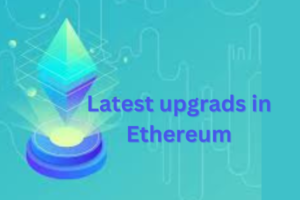
Ethereum, the world’s leading decentralized platform, has been undergoing a significant transformation over the past few years with its transition to Ethereum 2.0 (Eth2). Ethereum 2.0, also known as Serenity, is the next generation of the Ethereum blockchain. It’s a major upgrade that aims to improve scalability, securityand sustainability.
As we move deeper into 2024, it is important to understand the latest advancements in Ethereum 2.0 and what they mean for the future of decentralized applications (dApps), smart contracts and the broader blockchain ecosystem.In this blog post we will delve into the latest upgrades in Ethereum 2.0 and what they mean for the future of the network.
Ethereum’s Original PoW Mechanism
First we discuss originals as Ethereum, like many other cryptocurrencies, initially operated on a PoW mechanism. Under PoW, miners used powerful computers to solve complex mathematical puzzles. The process of successfully solving these puzzles, known as ‘mining,’ validated transactions and added new blocks to the blockchain. While secure, it was energy-intensive. The competitive nature of mining led to an arms race in computational power, resulting in significant electricity consumption and environmental concerns. PoW provided robust security due to the computational work required, making fraudulent activities like double-spending practically infeasible. However, this security came at the cost of scalability and speed, with the network often facing congestion and high transaction fees during peak usage.
Now we move to Ethereum Merg/ Upgradation to ETHEREUM 2.0
1. The Beacon Chain
The Beacon Chain is the first upgrade in Ethereum 2.0. The Beacon Chain was launched in December 2020 usually the backbone of Ethereum 2.0. It operates as the PoS consensus layer, running in parallel with the existing Ethereum mainnet during the transition period. It introduces a proof-of-stake (PoS) consensus algorithm, replacing the energy-intensive proof-of-work (PoW) algorithm. This change reduces energy consumption by 99.9% and increases network security.
2. The Shift from Proof-of-Work to Proof-of-Stake
One of the most significant changes in Ethereum 2.0 is the transition from the energy-intensive Proof-of-Work (PoW) consensus mechanism to the more eco-friendly Proof-of-Stake (PoS) model. Under PoS, validators are chosen to create new blocks and validate transactions based on the amount of cryptocurrency they “stake” as collateral. This shift drastically reduces Ethereum’s energy consumption, aligning with global sustainability goals and making Ethereum more environmentally friendly.
3. Shard Chains: Scaling Ethereum
Scalability has always been a challenge for Ethereum, with network congestion leading to high transaction fees and slower processing times. Shard Chains, another key component of Ethereum 2.0 aim to address this issue. Instead of processing all transactions on a single chain, Ethereum 2.0 will divide the network into smaller interconnected chains known as “shards.”
Each shard chain processes a portion of the network’s transactions, increasing overall throughput. This upgrade is expected to launch in 2023 and will increase Ethereum’s scalability by 64 times.
4. EVM Upgradation
The Ethereum Virtual Machine (EVM) is the brain of the Ethereum network, executing smart contracts and transactions. The EVM upgrade will improve execution speed, increase efficiency, and enhance security. This upgrade is expected to launch in 2023 and will make Ethereum more competitive with other blockchain networks.
5. EIP-4844: Proto-Danksharding
Ethereum Improvement Proposal (EIP) 4844, also known as Proto-Danksharding, introduces a new approach to data availability and shard chains. Proto-Danksharding focuses on improving the way data is handled and stored across the shards, paving the way for full Danksharding in future upgrades. This proposal aims to further optimize the data availability and reduce the overall cost of transactions, which is vital for making Ethereum more accessible and affordable for users.

6. Rollups: Layer 2 Scaling Solutions
To complement the Ethereum 2.0 upgrades, Layer 2 solutions like Rollups are becoming increasingly prominent. Rollups process transactions off the main Ethereum chain while still ensuring the security and integrity of the transactions through the mainnet. There are two primary types of Rollups: Optimistic Rollups and Zero-Knowledge Rollups (zk-Rollups). Both aim to alleviate network congestion and reduce transaction fees by bundling multiple transactions into a single batch.
7. Quantum Resistance Upgradation
The Quantum Resistance upgrade will make Ethereum resistant to quantum computer attacks. This upgrade is crucial as quantum computers can potentially break certain cryptographic algorithms used in blockchain networks.
8. Security Enhancement
The Ethereum Merge enhanced the network’s security. By transitioning from proof of work to proof of stake, Ethereum shifted to a system less vulnerable to certain types of attacks, such as the 51% attacks that are more feasible in PoW. In PoS, the network security is upheld by validators who have a substantial financial stake in the ecosystem. This stake acts as a deterrent against malicious actions, as validators stand to lose their investment if they attempt to compromise the network.
9. EIP-4844: Proto-Danksharding
Ethereum Improvement Proposal (EIP) 4844, also known as Proto-Danksharding, introduces a new approach to data availability and shard chains. Proto-Danksharding focuses on improving the way data is handled and stored across the shards, paving the way for full Danksharding in future upgrades. This proposal aims to further optimize the data availability and reduce the overall cost of transactions, which is vital for making Ethereum more accessible and affordable for users.
10. Future Upgrades: What Lies Ahead?
Looking ahead, Ethereum 2.0 is far from complete. Future upgrades and improvements will continue to build upon the foundation laid by the Beacon Chain and the Merge. Key areas of focus include further advancements in sharding, additional EIPs to enhance network functionality and ongoing optimizations for Layer 2 solutions.
The Ethereum community remains active in researching and developing new features to ensure the network’s long-term success. These future upgrades will likely continue to enhance Ethereum’s performance, security, and usability, solidifying its position as a leading platform for decentralized innovation.
Conclusion
Ethereum 2.0 represents a monumental shift in the world of blockchain technology. With its focus on sustainability, scalability, and enhanced security, Ethereum 2.0 is setting new standards for what blockchain networks can achieve. As these upgrades continue to roll out, they promise to unlock new opportunities for developers, businesses, and users, pushing the boundaries of what’s possible in the decentralized space.
Stay tuned to the latest developments and keep exploring, as Ethereum 2.0 is not just an upgrade—it’s a revolution in the making.
